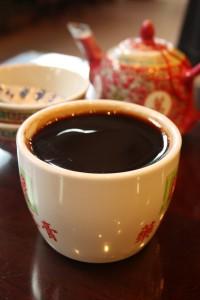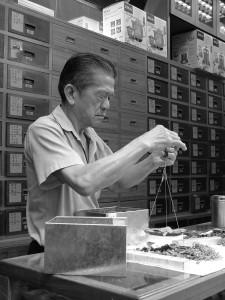Chinese tea is often nearly inseparable from the concept of yangsheng (养生) which can be translated literally as “nurturing the body”.
This can be attributed to firstly the Chinese belief that “药食同源” which can be translated as “medicine and food come from the same source”. Nothing is really a “pure food” or a “pure medicine”, at least when it comes to traditional remedies.
Hence, inasmuch as tea is a beverage, it is too a “medicine”.
Secondly, tea was first discovered as an herb with curative properties, capable of detoxification. Traditional Chinese Medicine practitioners down the ages have lauded the medicinal properties of tea including the most famous work “本草纲目”or Compendium of Materia Medica by 李时珍 (Li Shizhen) which has this to say:
“茶苦而寒,阴中之阴,沉也,降也,最能降火。火为百病,火降则上清矣。”
Translated roughly it means “Tea is bitter and “cold”, most suitable for reducing ‘fire’. Fire is the root of a myriad of diseases; with the reduction of fire the diseases are cleared”.
On our site, you will also see much of the TCM nature of tea where words like “cold”, “warming” and “neutral” appear, if you’re confused, that’s what this article’s all about.
Brief Overview of TCM Concepts
Four Qi (四气)

Image taken from sxc.hu
The four natures- although technically it should be 5 since “neutral” or 平- an absence of all 4 elements is also a nature.
寒- Cold
热- Heaty
温- Warming
凉 – Cooling
In general, food that are cold and cooling in nature “clear heat, purge fire and detoxify” while those that are “heaty” and warm:,warm up the internal body, expel coldness and promote physiological functions.[1]
Five Flavors (五味)
辛Pungent: promote distribution and circulation, enhance qi and blood activities. Generally, pungent herbs are used to treat external conditions and also blood or qi stagnation.
甘Sweet: lubricate and nourish the body, neutralize toxic effects, slow down acute reactions and arrest pain. Sweet herbs are often used to treat general weakness, spleen and stomach disharmony and painful conditions.
酸Sour: astringency and consolidation. Sour herbs are often used to treat conditions with sweating, cough, diarrhoea, emission, incontinence, and heavy menses.
苦Bitter: purge fire, dry dampness, promote bowel movements, and rectify qi movement. Bitter herbs are often used to treat conditions with fever, heat signs, asthma and cough, vomiting, hiccup, constipation, qi stagnation, abdominal mass, and conditions due to excessive dampness or virtual fire.
鹹Salty: dissipate accumulations, soften hardness and purgation. Salty herbs are often used to treat constipation, abnormal growths and accumulations.
*Above reproduced and edited for ease of reading from http://www.shen-nong.com/eng/principles/applicationyingyang-herbs-n-properties.html
How it Relate to Tea
Going back to Li Shizhen, in another section he wrote this in regards to tea:
“苦,甘,微寒,无毒” which is translated as “bitter, sweet, mildly cold and without toxin”.
At the same time, it bears mentioning that Li Shizhen lived from 1518-1593, during the Ming Dynasty and lived primarily in his hometown in Hubei.
While at that time dark tea and yellow tea would have been invented, it is less clear whether black tea and oolong tea was invented. If they had, it would have been unlikely to have spread from Fujian to Hubei where Li Shizhen stayed.
Dark tea though, wasn’t consumed much outside of the border areas at that time. Hence it stands to reason that the teas that Li Shizhen were referring to were most likely green tea and to a lesser extent yellow tea.
What are the TCM natures of each type of tea?
As a general guide the darker the liquor, the less “cooling” the tea.

Image taken from sxc.hu
While this sounds ‘un-scientific’ its basis can be explained as below.
In its raw form, tea is “cold”.
Green tea because it is not deliberately oxidized, retains most closely the original nature of tea and hence is “cold” in TCM nature.
The “un-oxidized” green teas have a clear, yellowish green liquor.
The nature of tea is most altered by oxidation and one of the contributing factors to the dark color of liquor is oxidation.
Hence, the more oxidized the tea, the less ‘cold’ it is.
Another factor is roasting or baking levels.
Roasted teas have ‘fire’ element to it and makes it more ‘warming’ compared to baked teas which in turn are more warm compared to steamed and then sun-dried teas.
Hence, putting the 2 together, we can conclude that in general, in terms of TCM nature we can expect from the coldest to the warmest:
i) Sundried green tea- Un-aged Sheng Puer
ii) Steamed green teas- Japanese greens, Enshi Yulu
iii) Baked green teas- Huangshan Maofeng, Taiping Houkui
iv) Un-roasted plus lowly oxidized oolong- ‘Green style’ Tieguanyin & Taiwanese Oolong
v) White teas
vi) Yellow teas
vii) Oolongs based on level of oxidation & roasting
viii) Black tea
ix) Dark tea
Of course this may vary based on age of tea or production methods but this should serve as a guideline.
The TCM nature of tea would be a fundamental component in understanding the basis of tea as a means of Yangsheng and finding a tea that suits us.
See here for more articles related to tea and health
[1] http://www.shen-nong.com/eng/principles/applicationyingyang-herbs-n-properties.html
